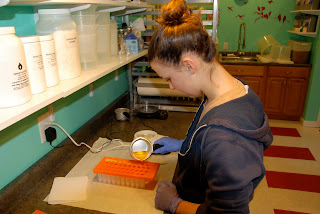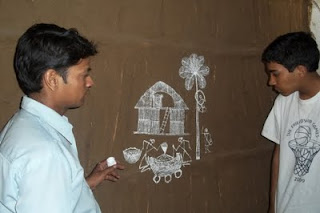By Chaitanya Bhat
The Project: Part 3
Today, I asked Madhukar the artisan more about the business aspect of his work.
When did your art become commercial? It took me 8 years to master technique, positioning, understanding the themes such as holi, Diwali,Savri,(puja-worship of indian Gods), Waghdev (a festival for the tiger god) and the narratives (katha) aspect (Ramayana).
Where do your orders come from? Shri Madhukar Janu Kharpade registered with the Panchayat Samiti (the District Body) which keeps him abreast with the calendar of events such as art exhibitions and workshops at various levels. He enrolled and participated in many such annual events (about 3-4 per year), where he established contact with the visitors (art connoisseurs, art dealers, middlemen, interior designers). This is how the orders started to trickle in from these events. This trickle grew into a steady flow, keeping him busy the whole year in executing these orders.
Were is your "studio"? What do you mean by studio? I paint in the serene undisturbed atmosphere of the village nestled in the undulating hills of Sakharsheth village in the Jawahar taluka (180 km from Mumbai). But occasionally I travel to different, more urban locales to decorate and paint walls.
How much do you charge for the different works and when do you get paid? For canvas as a medium, this is his scheme. For an individual, detailed canvas piece, I charge 800 rupees per square foot. For an order of more than 100 pieces, I charge 500 rupees per square foot. For light colored t-shirts of all sizes, my rates range from 200-500 rupees. For a dark colored background, I charge 100 rupees more. Bulk rates are negotiable. For Saris, I charge 1500 for light colored and 2000 for dark colored. For double bedsheets, I charge 1000 for light colored and 1200 for dark. For single bedsheets, it is 700 for light and 800 for dark. Dupattas are 250 for light and 300 for dark. Punjabi tops have the same pricing as the t-shirts.
For mud Pots, the range goes from 50 for small pots which a finger won't fit inside to 1000 rupees for the pots where a small child can hide inside of. I charge 600 rupees per square foot for a wall (2x3),I charge another 200 rupees to prepare the wall for painting. As an up-and-coming artist, I earned only 20,000 rupees to paint a 16x10 wall in an upmarket store (Ethnicity). Last year, I earned 44,000 rupees to paint a 5x11 wall in a government office. For greeting cards, the prices range from 20-50 depending on the size. For coasters, he charges 30. For a pen and cell phone remote stand, he charges 15. For all orders, he takes an advance payment of 40% and the rest upon completion.
How much will you charge us in the US to paint a wall in our school? I am excited to come and showcase my talents in the USA and decorate your lives. I don't know the pricing yet.
When you get an order, what process do you go through to do the painting? When I get an order for a canvas painting, if the customer so desires, I give them a quotation which is approved by the client, then I negotiate the rate and the finishing time with the customer. If the client wants a written contract I enter into one, otherwise it's all oral and is based on simple trust and faith. I take the 40% advance in cash which I use for either the painting supplies or the painting supplies as well as the raw materials. The first step is cutting the materials into the size required by the customer if it is canvas. My wife helps with cutting the fabric. Then the painting area is marked by demarcating a 2-inch border around the painting surface. The surface is then given a first coating of shen (cow dung) or geru (red mud) and dried. Another coat is applied and dried. This process is completed for all pieces of canvas before the actual painting work can begin. When the customer is deciding on the painting, I show samples of different themes. If the customer selects one of these samples, then the work is easy and needs no trial piece. If the client wants a new design, then usually there is one trial piece done to get the design down. Then when the painting is going on, I usually paint the shapes and my wife colors in the figures.
Has any of your orders shipped internationally? Not through me directly but through other people who organize it. If the person can carry it in their luggage, then there's no problem. Otherwise the best means for shipping is to send it either via courier or the post, inside a round, circular tube designed to carry pieces of artwork.
What is your ultimate goal for your work? My work is very erratic, sometimes I make nothing but then other months I make around 10,000 rupees. I want to expand by opening a showroom in Jawar. I want to earn money for my family and make a name for myself. I have also taught workshops in my village and I have found some young artists who could be included in the business.
The Project: Part 4
As I finished up the week, we decided to simulate the actual process of an order, because he didn't have one at the time. So we ordered greeting cards and two canvas drawings. I filled in the drawings and Madhukar did the original drawing of the shapes. This week has been a real experience for me and I will cherish it forever.


















































